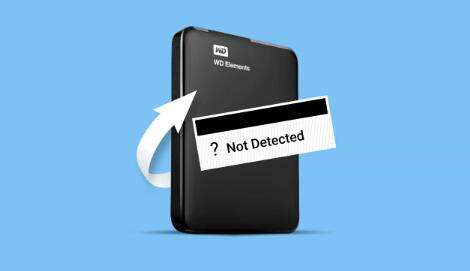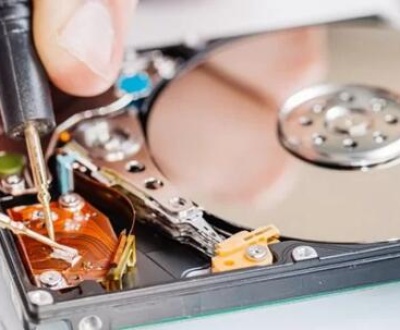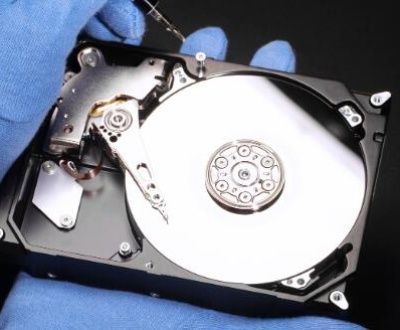Recovering data from a hard disk that is not detecting can be a daunting and technically complex task. However, with the right approach and tools, it is often possible to retrieve the data.
Why is My Hard Disk Not Detecting?
Before jumping into recovery solutions, it’s essential to understand why a hard disk may not be detected. Common reasons include:
Hardware Issues:
Power failure: The hard drive may not be receiving power due to a faulty cable, power supply, or the drive itself.
Cable or connection problems: A loose or damaged SATA or USB connection can cause the drive to become undetectable.
Port malfunction: The port or interface (USB, SATA) on your computer may be faulty.

Internal failure: The hard disk’s internal components, such as the platter, motor, or read/write head, may be damaged.
Software and System Issues:
Driver problems: Missing or outdated drivers may prevent the hard drive from being detected by the system.
File system corruption: Logical issues such as corrupted file systems can make the hard drive unreadable.
BIOS configuration: If the hard drive isn’t properly configured in the BIOS/UEFI settings, it won’t be detected by the operating system.
Virus or malware: Some malicious software can interfere with the detection of hard drives.
Hard Disk Damage:
Physical damage: Exposure to water, excessive heat, or a sudden impact can physically damage the drive.
Bad sectors: Over time, parts of the hard disk platter may fail, creating bad sectors that cause detection issues.
Troubleshooting the Problem
Before attempting data recovery, you can try a few troubleshooting steps to check whether the problem is something easily fixable.
1. Check Physical Connections
Start by inspecting the physical connections. If it’s an internal drive, make sure the SATA cables are properly connected. For external drives, try a different USB port, or better yet, test the hard drive on another computer. Sometimes simply using a different cable or port can fix detection issues.
2. Check BIOS/UEFI Settings
If your computer does not detect the drive, reboot and enter the BIOS/UEFI settings (usually by pressing a key like F2. DEL, or ESC during startup). Look for the hard drive in the storage configuration section. If the drive is not listed here, it could indicate a hardware failure.
3. Update or Reinstall Drivers
Check the Device Manager in Windows (or Disk Utility in macOS) to see if the drive appears under disk drives. If it does, but isn’t functioning correctly, try updating or reinstalling the drivers. On Windows, you can do this by right-clicking the device and selecting “Update Driver” or “Uninstall Device,” then rebooting the computer.
4. Use Disk Management
In Windows, the Disk Management tool can help you see if the drive is at least recognized by the system. Sometimes, a drive may be listed but not assigned a letter, making it invisible in the File Explorer. In this case, assigning a letter may resolve the issue.
5. Listen for Sounds
When you power up the drive, listen carefully for any unusual noises like clicking, grinding, or beeping. These sounds usually indicate a mechanical failure, and you should proceed with caution to avoid further damage.
Methods for Recovering Data from a Non-Detecting Hard Drive
Once you’ve tried troubleshooting and the hard disk is still not detecting, you can move on to data recovery methods. The choice of method will depend on whether the issue is due to physical damage, logical errors, or a system malfunction.
1. Using a Different Computer or External Enclosure
If the hard disk is not detecting on your system, connect it to a different computer or use an external hard drive enclosure. This method often works for internal drives that are not recognized by the system. By converting it into an external drive, you might be able to access the data if the issue was with the motherboard or the computer’s SATA port.
2. Use Data Recovery Software
If the hard drive is detected but inaccessible, professional data recovery software may help. Some examples of popular data recovery tools include:
Panda Assistant Data Recovery Software: This software is designed to recover data from malfunctioning hard drives, even those that may not initially appear in the system.
Recuva: A free recovery tool that is beginner-friendly and works well on logically corrupted drives.
Disk Drill: Known for its simple user interface and powerful scanning algorithms, Disk Drill can retrieve lost data from damaged drives.
EaseUS Data Recovery Wizard: A widely used software that offers a free trial version and is capable of deep scans to recover files from non-detecting or inaccessible drives.
Once installed, the software will scan the drive for recoverable data. Depending on the condition of the drive, the scanning process may take some time. After the scan, you can preview and recover the files to a safe location.
3. Try Command-Line Tools
For more tech-savvy users, command-line tools like TestDisk (for file system recovery) and PhotoRec (for file recovery) can be used to recover data from drives that are not detecting properly. These tools work at a low level and can recover data even if the partition table is damaged.
4. Repair the File System
If the drive is detected but showing as RAW or inaccessible, file system errors might be the problem. You can try to repair the file system using built-in tools like CHKDSK in Windows or fsck in Linux.
CHKDSK: Open Command Prompt as an administrator and type chkdsk /f X:, replacing “X” with the drive letter of your hard disk. This will attempt to fix file system errors and recover data from bad sectors.
fsck: If you’re using a Linux system, the fsck command can be used to repair file system issues on non-detecting drives.
5. Use a Data Recovery Service
If you suspect the problem is due to physical damage or if the above methods fail, it might be time to consider professional data recovery services. These services have specialized tools and clean rooms to handle physically damaged hard drives.
While data recovery services can be costly, they are often the best option if the hard drive has mechanical or severe electronic issues. The process generally involves:
Diagnosis: Technicians will assess the damage and provide a quote.
Repair: If necessary, parts like read/write heads, platters, or circuit boards may be replaced.
Data Extraction: Using sophisticated equipment, the technicians will attempt to read the data from the platters and reconstruct lost files.
If you’re located in specific areas such as Adelaide, Boca Raton, or Brooklyn, you may be able to find local data recovery services specializing in hard drive repair.
6. Freeze Method (Controversial)
The “freezing the hard drive” method is controversial and not generally recommended, as it can cause condensation, which may further damage the drive. However, in some cases, freezing a malfunctioning hard drive for a short period (wrapped in a plastic bag to avoid moisture) has been reported to help temporarily access the data. Use this as a last resort and only if all other options have been exhausted.
Preventative Measures for the Future
Once you’ve successfully recovered your data, it’s essential to take steps to prevent future data loss:
Regular Backups: Invest in a reliable backup solution, such as an external hard drive or cloud storage, to ensure your data is safe in case of drive failure.
Use Reliable Sync Software: Sync software like FreeFileSync or Resilio Sync can help you keep your data synchronized between multiple devices, reducing the risk of data loss if a drive fails.
Monitor Disk Health: Regularly check the health of your hard drives using S.M.A.R.T. (Self-Monitoring, Analysis, and Reporting Technology) tools, which can give you an early warning if the drive is about to fail.
Handle Drives Carefully: If your hard drive is an external one, always safely eject it before unplugging it to avoid file system corruption. Also, keep the drive in a cool, dry place, and avoid exposing it to physical shocks.
About us and this blog
Panda Assistant is built on the latest data recovery algorithms, ensuring that no file is too damaged, too lost, or too corrupted to be recovered.
Request a free quote
We believe that data recovery shouldn’t be a daunting task. That’s why we’ve designed Panda Assistant to be as easy to use as it is powerful. With a few clicks, you can initiate a scan, preview recoverable files, and restore your data all within a matter of minutes.
Subscribe to our newsletter!
More from our blog
See all postsRecent Posts
- Data recovery salt lake city utah 2025-04-18
- Data recovery sacramento 2025-04-18
- Data recovery miami 2025-04-18

 Try lt Free
Try lt Free Recovery success rate of up to
Recovery success rate of up to









